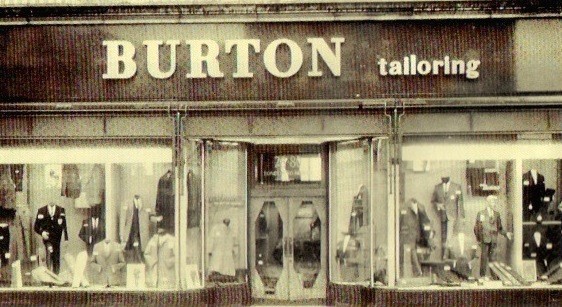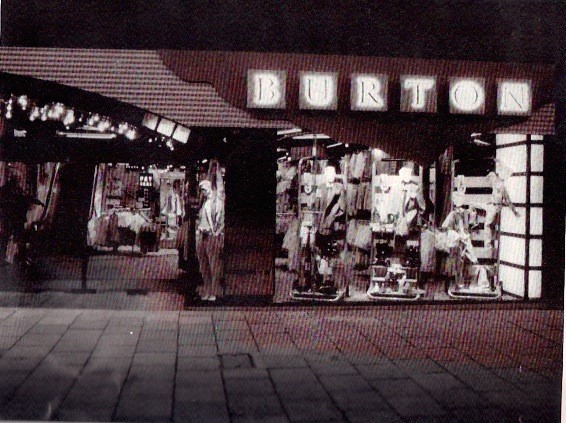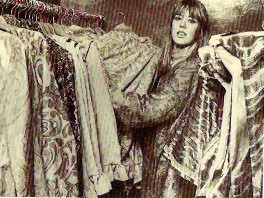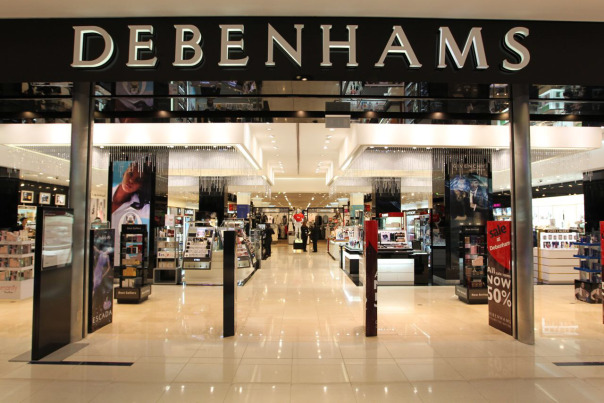How design got High Street cred
 First published in Campaign, September 1988
First published in Campaign, September 1988The British High Street began to swing in 1960s. Now it really hurtles
Last month, retail sales in Britain rose by two per cent. Two per cent! The figure doesn’t seem to mark an orgy of consumerism, but it promises to crowd this country’s prisons with more debtors than ever there were in the summer of 1968. Then, the High Street swung – a little, and mainly in London. Now it hurtles, and all over the country too.
It took the whole of the 1960s for turnover in Britain’s shops to double. Over the past two decades, however, total retail sales in shops have shot up from less than £15 billion to well over £100 billion. Only in the 20 years gone by have the big chains crushed the corner shop.
Before 1968, multiple establishments accounted for less than 40 per cent of retail business in the UK, and showed few signs of concentration. Since that date, they have come to take 70 per cent of shoppers’ money. Like the independents, their numbers have halved. But the 25,000 who remain are strong, while the nation’s 200,000 family-owned stores, last outposts of the brown paper bag, have their doors open to a difficult future.
So folk-memory of the 1960s, of one long hippie spending spree, colourful father to today’s boom in retail design, really won’t do.
Before 1968, the average British worker’s weekly wage was but £3. The 1960s were the age of Birmingham’s monstrous Bull Ring and the Elephant and Castle shopping centre; of thriving bingo halls and closed-up cinemas; of pubs decked out in velvet and steak houses in deepest red; of mail order paid by installments, and of Green Shield stamps. There is little to connect the era with 1988.
It is true that Burton was around in 1968. Yet the Eighties, not the 1960s, were when Sir Ralph Halpern emerged to segment his markets and develop Top Shop, Top Man, Burton, Principles, Principles for Men, Harvey Nichols, Debenhams and Radius.
Likewise George Davies (Next, Next for Men, Next to Nothing, Next Too, Next Interiors, Next Accessories, Next Directory) is no child of the 1960s, but an Eighties phenomenon.
Even fashion survivors from the 1960s in fact date from earlier times. Michael Barrie, who has taken over Take Six (1966-87), first began trading in 1948. Mary Quant started Bazaar, on the King’s Road, way back in 1955. John Stephen set up on Carnaby Street in 1959. Theirs was a long haul, and one that only began to get easier by the 1970s.
Fashion was as pivotal to the High Street in 1968 as it is in 1988, but its role was quite different. Then, converging with music and with a large generation of youth that had – for the first time since the war – some money in its pockets, a mere 15,000 boutiques gave a few architects and graphic designers a chance to break the stranglehold which shopfitters had over shop environments.
Now, giants such as Burton and Next have not simply created a whole new and populous discipline known as retail design: much more importantly, they have helped develop a sensibility toward design on the part of all age-groups, the world of advertising, and influential clients – ASDA, British Rail, Granada, Midland Bank and Woolworth.

Burton in the 1960s . . . Sir Ralph Halpern had yet to emerge to segment his markets
Before 1968, Britain’s uniquely powerful shopfitting industry, almost bereft of designers, decked out names that have vanished – United Drapery Stores (950 outlets), Pricerite (58). There was some work for architects Bronek, Katz and Vaughan, as well as for Yorke, Rosenberg and Marshall. Design Research Unit handled Peter Robinson. Otherwise, however, the main design entrée was for US consultancies; and while Raymond Loewy’s organisation acquitted itself well with John Lewis, other American companies could only offset a frequent relapse into Marie Antoinette aesthetics with unrivalled analysis of merchandise and marketing data.
Today times are not so lean. Some shops change their look every three to five years, not every eight to ten. Britain’s only undergraduate course in retail design, run by Anthony Parsons at London’s College of Distributive Trades, has just finished its first year, and the largest design consultancies boast, belatedly, specialist retail marketing expertise.
Design budgets, aided by much larger advertising budgets, have helped make retailers into some of the best-remembered brands in Britain. Meanwhile, both UK retailers and UK retail designers have taken the fire back to the US: Sainsbury has acquired Shaw, in New England; Marks and Spencer has purchased Brooks Brothers; Fitch has merged with design consultants RichardsonSmith.
Back in Britain, the benefits of post-1981 retailing to the consumer have been tangible. There are more chains, but also more choice. There is greater merchandise specialisation, but also greater product coordination.
For women at work and for Britain’s multiplying motorists, late-night shopping and easy-to-park stores away from city centres are a boon. Some of the dark, gusty, concrete walls of the 1960s at least sport airy glass roofs and more wholesome catering; edge-of-town food superstores radiate hygiene and fresh produce; out-of-town DIY merchants make strenuous efforts to persuade their domestic suppliers to match foreign standards of product quality.

Burton in the Eighties . . . it has developed a sensibility towards design to all age-groups
Building upwards in the tighter, comparison-shopping urban context, and spreading outwards to provide convenience shopping: these are trends, symbolised by the escalator and trolleys on tarmac, which show how much the High Street has changed since 1968. But the widely hyped decline of retailing in the inner city today is as nothing compared with the demise of neighbourhood shopping then. Indeed in many ways the high street has been buoyed up by newly competitive service providers – banks, building societies and, very recently, utilities.
Above all, it has improved in terms of interiors. Gone, with the never-ending ‘everything must go’ sales of the hyper-inflationary 1970s, are the strips and strips of burning fluorescent lights, the acres of washable, scratchproof imitation wood laminates, the yards of groceries in cardboard boxes. Today’s stores, often under new management, persuade one audience with tiny, twinkling lowvoltage lamps, another with terrazzo floors, another with jerseys stacked flat in burnished walnut shelves.
With all this modernity, nevertheless, it is fair to mourn the passing of the boutique, just as it is fair to celebrate the continuity of Habitat.

1960s boutiques: purple floors and chocolate-brown walls
If today’s spatial dynamic in retailing is vertical and lateral, that of 1968 was basically cellular. Just as record shops had sound-insulated booths to groove in (where are they now?), so the point of the 1960s boutique was to dive out of open-air, High Street, bourgeois consumption into an altogether pokier, more exotic variety. Boutiques were about purple floors, chocolate-brown walls and cast a layer-off changing-rooms: there was an element of secrecy about them.
Architects Campbell, Zogolovitch and Gough did cave-like boutiques. The Way In, a cell within Harrods, had deep-purple carpets, purple ceilings and walls, and purple cafe stools in GRP. Nigel Waymarth’s Granny Takes a Trip, on the Portobello Road, was, beneath six or seven changes of fascia in the 1960s, a lush, dark world of feather fans and funny frock coats.

Next’s Department X… the innovative new mechanical store
Boutiques did go in for bright display, of course. Mr Freedom, designed by Jon Weallans, and the mural on the Apple Shop, Baker Street – designed by two 23 yearold Dutchwomen known as The Fool – were brassy enough. Again, the seminal radiused windows and corners of the Chelsea Drugstore, designed by King’s Road kings Garnett Cloughley Blakemore and Associates, oozed a breezy, astronautic sensuality. But the basic motifs in boutiques paralleled the saturnine clubs of the 1960s: the UFO, the Middle Earth, the Marquee and the Arts Lab.
As for Terence Conran’s Fulham Road emporium – founded in 1964 for £1.50 per square foot – it pioneered the whole business of targeting a particular lifestyle. Taking off from British toy shops (Play and Learn, James Galt) and French warehouses, Conran coordinated, piled his kitchen utensils high, and went on to set up next to Heal’s and in Manchester and Brighton too. Only by 1970, though, were his outlets really profitable.
In the 1980s we have lost the subterranean charms of Biba and the open optimism of 1960s petrol stations (‘The Esso sign means happy motoring’). From the 1960s we have retained self-service, and, with it, the centrality of pack design. Yet, when we document the real past outside London, we miss little from the retailing of 1968. London impressed the media and the tourists; the provinces barely registered.
Take, for example, Leeds. Compare the entries for that city, 1968 v 1988, in the indispensable Retail Directories published by Newman Books, London. It is evident that, on or nearby the main High Street, Briggate, there was a plurality of fashion and footwear stores and no fewer than nine jewellers. The boutiques, if they deserved the title, seemed confined to shops named ‘Amber’ and ‘Miss Janet’.
There were five furniture stores, with names daunting (‘Super Bargain Centre’) and all too familiar today (Woodhouse; Cavendish). We may lament the passing of Attrills ironworkers, Coombes shoe repairers, Gigi’s coffee bar, the Ceylon Tea Centre and Kitchens’ musical instruments; but we hardly shed a tear for the demise of two motorbike parts dealers, the 2s 6d shop (housewares) and the Locarno Dance Hall.
Today’s Leeds has lost only 10 per cent of its half-million population since 1968. It has gained Marks and Spencer, Habitat, Virgin, Zodiac Toys, a lot of fast-food places, several computer vendors, a Housing Information Office, a glazier, a baker and a club called Hollywood Days and Hollywood Nights.
The mix, no doubt, is not to everybody’s taste. But the typical British High Street of 1988 is a vastly more stimulating place to be than the main drag of yesteryear.
Fmr President of Kenya on Trump cutting off foreign aid:
“Why are you crying? It’s not your government, he has no reason to give you anything. This is a wakeup call to say what are we going to do to help ourselves?”
America first is good for the world.
Our entire Green Socialist establishment should be banged up under the ‘Online Safety’ laws, for spreading demonstrable lies (the ‘climate crisis’), causing non-trivial harm to the industrial working class, ordinary drivers, farmers, taxpayers etc, etc.
#Chagos? #Mauritius PM Navin Ramgoolam "is reported to want Starmer to pay £800m a year, plus ‘billions of pounds in #reparations’." (14 January) https://www.spiked-online.com/2025/01/14/the-chagos-islands-deal-is-an-embarrassment/
Now the Torygraph wakes up https://telegraph.co.uk/gift/1ff8abbb462cd609
Read @spikedonline - first with the news!
Articles grouped by Tag
Bookmarks
Innovators I like

Robert Furchgott – discovered that nitric oxide transmits signals within the human body

Barry Marshall – showed that the bacterium Helicobacter pylori is the cause of most peptic ulcers, reversing decades of medical doctrine holding that ulcers were caused by stress, spicy foods, and too much acid

N Joseph Woodland – co-inventor of the barcode

Jocelyn Bell Burnell – she discovered the first radio pulsars

John Tyndall – the man who worked out why the sky was blue

Rosalind Franklin co-discovered the structure of DNA, with Crick and Watson

Rosalyn Sussman Yallow – development of radioimmunoassay (RIA), a method of quantifying minute amounts of biological substances in the body

Jonas Salk – discovery and development of the first successful polio vaccine

John Waterlow – discovered that lack of body potassium causes altitude sickness. First experiment: on himself

Werner Forssmann – the first man to insert a catheter into a human heart: his own

Bruce Bayer – scientist with Kodak whose invention of a colour filter array enabled digital imaging sensors to capture colour

Yuri Gagarin – first man in space. My piece of fandom: http://www.spiked-online.com/newsite/article/10421

Sir Godfrey Hounsfield – inventor, with Robert Ledley, of the CAT scanner

Martin Cooper – inventor of the mobile phone

George Devol – 'father of robotics’ who helped to revolutionise carmaking

Thomas Tuohy – Windscale manager who doused the flames of the 1957 fire

Eugene Polley – TV remote controls



0 comments